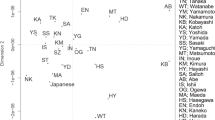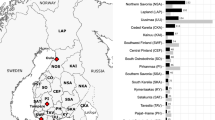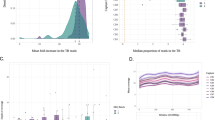Abstract
The biological behavior of the Y chromosome, which is paternally inherited, implies that males sharing the same surname may also share a similar Y chromosome. However, socio-cultural factors, such as polyphyletism, non-paternity, adoption, or matrilineal surname transmission, may prevent the joint transmission of the surname and the Y chromosome. By genotyping 17 Y-STRs and 68 SNPs in ~2500 male samples that each carried one of the 50 selected Catalan surnames, we could determine sets of descendants of a common ancestor, the population of origin of the common ancestor, and the date when such a common ancestor lived. Haplotype diversity was positively correlated with surname frequency, that is, rarer surnames showed the strongest signals of coancestry. Introgression rates of Y chromosomes into a surname by non-paternity, adoption, and transmission of the maternal surname were estimated at 1.5−2.6% per generation, with some local variation. Average ages for the founders of the surnames were estimated at ~500 years, suggesting a delay between the origin of surnames (twelfth and thirteenth centuries) and the systematization of their paternal transmission. We have found that, in general, a foreign etymology for a surname does not often result in a non-indigenous origin of surname founders; however, bearers of some surnames with an Arabic etymology show an excess of North African haplotypes. Finally, we estimate that surname prediction from a Y-chromosome haplotype, which may have interesting forensic applications, has a ~60% sensitivity but a 17% false discovery rate.
Similar content being viewed by others
Log in or create a free account to read this content
Gain free access to this article, as well as selected content from this journal and more on nature.com
or
References
King TE, Jobling MA : What’s in a name? Y chromosomes, surnames and the genetic genealogy revolution. Trends Genet 2009; 25: 351–360.
Poznik GD, Henn BM, Yee MC et al: Sequencing Y chromosomes resolves discrepancy in time to common ancestor of males versus females. Science 2013; 341: 562–565.
Gusmao L, Sanchez-Diz P, Calafell F et al: Mutation rates at Y chromosome specific microsatellites. Hum Mutat 2005; 26: 520–528.
Sykes B, Irven C : Surnames and the Y chromosome. Am J Hum Genet 2000; 66: 1417–1419.
King TE, Jobling MA : Founders, drift, and infidelity: the relationship between Y chromosome diversity and patrilineal surnames. Mol Biol Evol 2009; 26: 1093–1102.
McEvoy B, Bradley DG : Y-chromosomes and the extent of patrilineal ancestry in Irish surnames. Hum Genet 2006; 119: 212–219.
Gymrek M, McGuire AL, Golan D, Halperin E, Erlich Y : Identifying personal genomes by surname inference. Science 2013; 339: 321–324.
Grimes BF : Ethnologue. Languages of the world. Summer Institute of Linguistics: Dallas, TX, USA, 1988.
Mateos P, Tucker D : Forenames and surnames in Spain in 2004. Names 2008; 54: 156–184.
Rodriguez-Larralde A, Gonzalez-Martin A, Scapoli C, Barrai I : The names of Spain: a study of the isonymy structure of Spain. Am J Phys Anthropol 2003; 121: 280–292.
Moll F de B : Els Llinatges Catalans. Ed. Moll: Mallorca, Spain, 1982.
Moreu-Rey E : Antroponímia: Història dels Nostres Prenoms, Cognoms i Renoms. Edicions Universitat de Barcelona: Barcelona, Spain, 1993.
Mulero JJ, Chang CW, Calandro LM et al: Development and validation of the AmpFlSTR Yfiler PCR amplification kit: a male specific, single amplification 17 Y-STR multiplex system. J Forensic Sci 2006; 51: 64–75.
Martinez-Cruz B, Ziegle J, Sanz P et al: Multiplex single-nucleotide polymorphism typing of the human Y chromosome using TaqMan probes. Investig Genet 2011; 2: 13.
Rocca RA, Magoon G, Reynolds DF et al: Discovery of Western European R1b1a2 Y chromosome variants in 1000 genomes project data: an online community approach. PLoS One 2012; 7: e41634.
Van Oven M, Van Geystelen A, Kayser M, Decorte R, Larmuseau MHD : Seeing the wood for the trees: a minimal reference phylogeny for the human Y chromosome. Hum Mutat 2014; 35: 187–191.
Excoffier L, Lischer HEL : Arlequin suite ver 3.5: a new series of programs to perform population genetics analyses under Linux and Windows. Mol Ecol Resour 2010; 10: 564–567.
R core team R: A Language and Environment for Statistical Computing. R Foundation for Statistical Computing: Vienna, Austria, 2012.
Martínez-González LJ, Martínez-Espín E, Álvarez JC et al: Surname and Y chromosome in Southern Europe: a case study with Colom/Colombo. Eur J Hum Genet 2012; 20: 211–216.
Martinez-Cruz B, Ioana M, Calafell F et al: Y-chromosome analysis in individuals bearing the Basarab name of the first dynasty of Wallachian kings. PLoS One 2012; 7: e41803.
Rębała K, Martínez-Cruz B, Tönjes A et al: Contemporary paternal genetic landscape of Polish and German populations: from early medieval Slavic expansion to post-World War II resettlements. Eur J Hum Genet 2013; 21: 415–422.
Fadhlaoui-Zid K, Haber M, Martínez-Cruz B, Zalloua P, Benammar Elgaaied A, Comas D : Genome-wide and paternal diversity reveal a recent origin of human populations in North Africa. PLoS One 2013; 8: e80293.
Zhong H, Shi H, Qi X-B et al: Extended Y chromosome investigation suggests postglacial migrations of modern humans into East Asia via the northern route. Mol Biol Evol 2011; 28: 717–727.
Dupanloup I, Bertorelle G : Inferring admixture proportions from molecular data: extension to any number of parental populations. Mol Biol Evol 2001; 18: 672–675.
Romualdi C, Balding D, Nasidze IS et al: Patterns of human diversity, within and among continents, inferred from biallelic DNA polymorphisms. Genome Res 2002; 12: 602–612.
Larmuseau MHD, Vanoverbeke J, Van Geystelen A et al: Low historical rates of cuckoldry in a Western European human population traced by Y-chromosome and genealogical data. Proc Biol Sci 2013; 280: 20132400.
Boattini A, Sarno S, Pedrini P et al: Traces of medieval migrations in a socially stratified population from Northern Italy. Evidence from uniparental markers and deep-rooted pedigrees. Heredity (Edinb) 2015; 114: 155–162.
Pérez-Molina I : Honour and Disgrace: Women and the Law in Early Modern Catalonia. Edicions Universitat de Barcelona: Barcelona, Spain, 2001.
Sahlins P : Boundaries: The Making of Spain and France in the Pyrenees. University of California Press: Berkeley and Los Angeles, CA, USA, 1989.
Cabré A : El Sistema Català de Reproducció. Editorial Proa: Barcelona, Spain, 1999.
Corominas J : Onomasticon Cataloniae. Curial, Caixa d’Estalvis i Pensions de Barcelona, La Caixa: Barcelona, Spain, 1989.
Hammer MF, Behar DM, Karafet TM et al: Extended Y chromosome haplotypes resolve multiple and unique lineages of the Jewish priesthood. Hum Genet 2009; 126: 707–717.
King TE, Ballereau SJ, Schurer KE, Jobling MA : Genetic signatures of coancestry within surnames. Curr Biol 2006; 16: 384–388.
Larmuseau MHD, Vanderheyden N, Van Geystelen A, van Oven M, de Kniff P, Decorte R : Recent radiation within Y-chromosomal haplogroup R-M269 resulted in high Y-STR haplotype resemblance. Ann Hum Genet 2014; 78: 92–103.
Solé-Morata N, Bertranpetit J, Comas D, Calafell F : Recent radiation of R-M269 and high Y-STR haplotype resemblance confirmed. Ann Hum Genet 2014; 78: 253–254.
Acknowledgements
We especially thank the >2500 participants in the study for giving their samples and genealogies, and, in many cases, for providing relevant details about the history of their surnames. Cristina de Vasconcelos superbly organized the logistics of sample collection. Cristina Junyent (www.cienciaensocietat.org) put her media contact list at our disposal, which was crucial for raising awareness for the project. Osmel Companioni (Institut Català d’Oncologia) advised us about the DNA sampling and extraction protocols. Irina Badell and Isshak Mrabet collaborated in DNA extraction. Advice on study design was provided by Joan Peitaví (Université de Perpignan), August Bover (Universitat de Barcelona), Enric Guinot (Universitat de València), Jordi Lleonart (Institut de Ciències del Mar), Anna Cabré and Joana Maria Pujades (Centre d’Estudis Demogràfics, project ‘Five centuries of marriages’, ERC-2010-AdG-26976), and Albert Turull (Universitat de Lleida). Funding was provided by the Institut d’Estudis Catalans and by the Spanish Ministry of Economy and Innovation (grant CGL2013-44351-P).
Author information
Authors and Affiliations
Corresponding author
Ethics declarations
Competing interests
The authors declare no conflict of interest.
Additional information
Supplementary Information accompanies this paper on European Journal of Human Genetics website
Supplementary information
Rights and permissions
About this article
Cite this article
Solé-Morata, N., Bertranpetit, J., Comas, D. et al. Y-chromosome diversity in Catalan surname samples: insights into surname origin and frequency. Eur J Hum Genet 23, 1549–1557 (2015). https://doi.org/10.1038/ejhg.2015.14
Received:
Revised:
Accepted:
Published:
Issue date:
DOI: https://doi.org/10.1038/ejhg.2015.14
This article is cited by
-
Middle eastern genetic legacy in the paternal and maternal gene pools of Chuetas
Scientific Reports (2020)
-
Inferring the history of surname Ye based on Y chromosome high-resolution genotyping and sequencing data
Journal of Human Genetics (2019)
-
People from Ibiza: an unexpected isolate in the Western Mediterranean
European Journal of Human Genetics (2019)
-
Relating Clans Ao and Aisin Gioro from northeast China by whole Y-chromosome sequencing
Journal of Human Genetics (2019)
-
Human Y-chromosome variation in the genome-sequencing era
Nature Reviews Genetics (2017)



